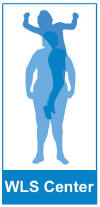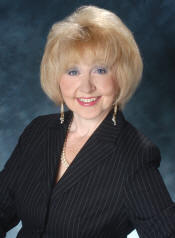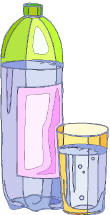|
WLS Center E-Newsletter
A
FREE publication from
http://www.wlscenter.com
Hosted by
Barbara Thompson
Author of:
Weight Loss Surgery:
Finding the Thin Person Hiding Inside You.
|
 |

 |
OK I admit it. I’m cheap. It still bothers
me to pay $1.15 for a bottle of water in a vending machine. I
still think water should be free. Yet I don’t think twice about
paying that same amount for a bottle of diet soda which is not
good for me. Go figure! I need to change my attitude about
bottled water and my research on bottled water has helped that.
Somewhat!
This month I am continuing the series on
water and am including a fun activity for your support group to
try. See the article below.
 |

|
In This Issue |
|
|
* Research Article: Bottled Water
* Anti-Aging Face Cream
* Advice: Risks of Weight Loss Surgery
* Recipe: Shrimp Dip
*
Success Story: Marisette Edwards
* Spreading the Word in Texas, Iowa, PA and New York |

 |
|
Research Article (Part 2):
|
|
|
|
Take a walk down the soft drink aisle of a
grocery store and you will see a growing section either at the end
or taking up a major portion of an aisle. It is the bottled water
section. Bottled water is increasing in popularity, so much so
that in 2002, we spent $7.7 billion on bottled water in this
country. If you number among the more than 50% of the population
that drinks bottled water, ask yourself why. Is it because you
feel it is purer or safer? Or do you buy it for the taste or the
convenience. Be a responsible consumer and find out in the article
that follows what you are buying.
Bottled water is regulated by the Food and
Drug Administration, well usually! It is true that the FDA sets
strict guidelines for bottled water, but those guidelines only
apply to bottled water that crosses State borders to be sold, and
60% to 70% of water is sold within its own State.
Here are the different kinds of bottled water
and there really is a difference:
Spring Water – It really does come
from springs, but only if the word “spring” is stated on the
bottle. A spring is an opening in the earth through which water
flows naturally. However, the water bottlers are permitted to
drill a hole or well to tap into the spring, but the well cannot
keep the water from flowing naturally. The “Preserve the Free
Flowing Spring advocates” apparently won that battle!
Municipal Water – Guess what, 25% of
bottled water is tap water. However, the water must be filtered
and processed. If you see a bottle and it says “purified” water,
it is tap water that has been filtered.
Artesian Water – This is water from an
artesian well or water that flows above the water table.
Mineral Water – This water must have a
minimum proportion of dissolved minerals in it occurring
naturally.
Naturally Sparkling – This water must,
in fact, be from a natural source that is carbonated. It cannot
have carbonation pumped into it.
Glacial Water – This does not have to
come from a glacier. I guess it can come from anywhere – go
figure!
What to watch out for:
 |
Don’t look at the picture on a
bottle. Pictures are not regulated, only words are. A
bottle of municipal water can have a picture of a pure
flowing spring on it that has nothing to do with the
contents inside. Don’t be fooled. |
 |
Select national brands so they
are regulated by the Food and Drug Administration. Only when
water crosses State lines do the federal regulations come
into play |
 |
Don’t drink a bottle of water
and then refill it without cleaning it out well. |
Try a taste test in your support group:
Write a category on a slip of paper (mineral
water, purified water, spring water, etc.) and have each person
buy a bottle or two from that category. That will certainly get
people to read labels. Also have someone bring your own local tap
water in a bottle. Then have a blind taste test in paper cups
and have people vote for their favorite water. Write up the
results and have someone email them to me at
Barbara@wlscenter.com and I will post the results! You might
be surprised. Many people actually prefer their own tap water
because it is what they are accustomed to. |

 |
Anti-Aging Face
Cream
|
|
You have had your surgery and are starting to
look really good. You have taken care of yourself on the inside,
now it is time to take care of how you look on the outside. It’s
time to take care of your skin which is actually the largest organ
of the body.
If you are 35 years old or older, you are
probably starting to see lines, scaly or dull skin. You are feeling
better than you have in many years, yet your skin still looks how
you used to feel before surgery.
I have been using a fantastic anti-aging
skincare product and I mention it to you because I have had so many
people comment on how good my skin looks ever since I have started
using it. The basic system contains three products, a cleanser, a
firming activator and a moisturizer. Four additional products
provide solutions to specific skin problems.
Click on the banner below for more information
and to order. All orders placed through this special website will
receive a 20% rebate check through May 15th.
If you have any questions, call my office at
(877) 440-1518.

|

|
 |
| |
Risks of Weight Loss Surgery |
|
|
Question:
Dear Barbara,
I am still pre-op. The closer I get to the probability of the
weight loss surgery really happening, the more concerned I am about
morbid complications including death.
I have discussed this with my husband, and with
the surgeon. When I mention it in chat rooms I often get rather
angry responses, like I "should have" figured that out by now. That
is not much help.
I have had several types of surgeries in my
lifetime, and waiting for surgery has always been the hardest time.
Concerns about "what if this is the time I don't make it?" surface,
big-time. Doctors and counselor have always reassured me that this
is normal and I'll get through it.
Some of my guilt feelings come from having been
raised a Christian and how dare I be questioning some of that now?
I also worry about what would happen to my cats if I were gone?
Most insurance companies and 99.99% of the
public see weight loss surgery as elective. So could this be
considered by some as a short-circuit suicide if I died?
I know some of that is unreasonable thinking,
but it happens. It is human. Since this surgery really still is
considered high-risk, and, since I still have the stressful job
of telling my family, could you please help me (and lots of
other readers) how to deal with this whole
morbidity/mortality issue with weight loss surgery? Thanks.
It is okay to use this in your newsletter, if
you think it would help others. But please no flaming. Thanks. Been
there, gotten that.
Lauren Merryfield
res0zoyz@verizon.net
Answer:
Dear Lauren,
Absolutely no flaming here! I never do that. Actually you sound so
much like me before my surgery. I was absolutely terrified, so I
can certainly understand how you feel.
What may help is to understand the risks of the
surgery through some facts. In a 2001 study of almost 11,000
patients the International Bariatric Surgery Registry found that 93
% of patients had no complications whatsoever. Of the 7% that had
complications, they ranged from minor complications such as
dehydration, hernias and ulcers to major complications such as a GI
leak, cardiac arrest and respiratory failure. The major
complications are often the result of the patient’s health going
into the surgery. A rate of 93% with
absolutely no complications is very good indeed.
As for the risk of death, the mortality rate is
1 in 200. The younger and the healthier you are, the less likely you
will encounter complications. So your overall health is a factor.
Another factor is your surgeon’s experience. Statistically, you are
much safer having your surgery performed by a surgeon who has done
more that 100 surgeries. There is definitely a learning curve.
It is not true that the insurance industry
considers weight loss surgery elective. They would never cover it
if they did. The National Institutes of Health endorses the surgery
as the only method for those of us who are morbidly obese to be of
normal weight. They set the guidelines and the insurance industry
follows those guidelines.
Another consideration is how at risk you are
staying morbidly obese. There is an ongoing study being done in
Sweden. They reported on the study after 6 years. It is a huge
study involving 2,000 morbidly obese people. One thousand in the
study had weight loss surgery and the other 1,000 dieted. Of the
1,000 that had surgery, 3 had died after 6 years. Of the 1,000 that
dieted, 27 had died after 6 years. You are much safer being of
normal weight than staying morbidly obese.
I hope that these facts have helped you. I
would like to invite people to send you words of encouragement. And
knowing how kind my readers are, I know that no one will flame you!!
Take care.

If you would like to offer Lauren some words of
advice or encouragement, email her at
res0zoyz@verizon.net. She would like to hear from anyone else
that can offer her some encouragement.
If you would like to ask me a question and
agree to my sharing it in a future e-newsletter, send it to me at
Barbara@wlscenter.com and indicate “E-newsletter Advice” in the
subject line and mention that I can use the question in the
e-newsletter somewhere in the email. |

 |
Recipe:
Shrimp Dip |
|
Here is a great basic recipe for shrimp dip. I
got the idea of dips from David Fouts, the bariatric chef when we
did the telephone seminar together called “It’s All About Food.” In the
telephone seminar, David mentioned that dips are a great source of edible
and really delicious protein from your pureed stage on.
For other great cooking ideas, get a copy of
the telephone seminar on CD at
http://www.wlscenter.com/Teleseminar/ChefDavid/ChefDavid.htm
Shrimp Dip
1 cup of sour cream
1 package (3 ounces) cream cheese, softened
1 envelope dry onion soup mix
1 can (5 ounces) shrimp drained and chopped very fine
1 Tablespoon chopped pimento (optional)
1 Tablespoon green pepper finely chopped (optional)
Mayonnaise, enough to make the dip and
consistency to your liking
Mix all ingredients together and eat with very
thin crackers or, better still, with raw vegetables. Use the lite
versions of sour cream, cream cheese and mayonnaise to make this a
lower fat and lower calorie recipe.
If you have a recipe that you would like to
share in future issues of this newsletter,
please send it to
me at
Barbara@wlscenter.com |

|
|
|
|
I want to offer a special thanks to
Marisette Edwards. Here is her story:
Dear Barbara,
It has been just over a year since I had my RNY gastric bypass
surgery, so I guess it's time to share my success story with you and
your readers. I can't believe the year has gone so fast!
At the end of April, 2003, as I was thoroughly
chewing my ¼ cup of cottage cheese three weeks after my Roux-en-Y
gastric bypass surgery, I watched an Oprah show on people who lost
significant amounts of weight without surgery (emphasis
Oprah’s). Boy, did that make me feel like a slacker – not much
change from the way I’ve felt about myself for much of my life as
far as weight was concerned. I still struggle with the nagging
feeling that I should have been able to do this on my own. But
first, here is some history...
Like many of the people I talk to in my support
group, I always struggled with my weight and lost my battle during
my pregnancies, gaining 30-50 pounds with each. I was only able to
maintain a low weight in high school and college by forcing myself
to eat a very small amount of food (roughly equal to what I eat now
post-surgery; only now I have the help of a tiny stomach and don't
have to make myself do it). I’ve spent decades trying to lose
weight the “right”, slow, “better life-style” way. I worked hard at
it, such as the 15 months I exercised 6 hours a week until a back
injury forced me to quit. (I had lost 15 pounds during that time,
so only another 10 or so years of that would have gotten me to
goal). I found out that I had degenerative joint disease in my back
and was told losing weight might slow down the progress of the
disease. Having watched my (normal-weight) father suffer through
three back surgeries, I felt it had come to a choice between surgery
now or surgery later. I also felt that my system was a little like
the heating system at work – there was no way to tell exactly why it
was running hot in spite of lowering the thermostat, but until a
cause could be found there were mechanical ways to change the
temperature.
I spent months researching weight loss surgery
and surgeons to determine who would be most qualified to perform
such risky surgery on me. Then I spent another nine months meeting
the criteria set forth by the insurance company and my surgeon.
Like you, Barbara, I decided Dr. Phillip Schauer was the best of the
best, and he is exactly as you describe in your book. By the time I
had the surgery, over a year had passed since I admitted to myself
that my health was deteriorating and there was nothing more I could
do on my own. Dr. Schauer made it clear to me what risks I was
taking as well as the changes in exercise, eating, and vitamin
regimen I would need to agree to. My last comment to him in my
pre-op appointment was, “I feel kind of weird doing something this
drastic to myself when there’s nothing really wrong with me.” He
replied that the obesity was already doing damage that could be
measured in my blood pressure, joint pain, and asthma, and it was
most certainly going to cause more problems later. Having the
surgery when I was relatively healthy was ensuring the lowest risk
and the highest chance of reversing the damage. He emphasized that
obesity is recognized by the National Institutes of Health as a
chronic disease and with 120 pounds to lose I only had a 1% chance
of succeeding at losing the weight permanently on my own.
I started out at 266 pounds and size 24. I’m
now below 160 pounds and size 8-10. I go to the gym regularly –
something I couldn’t maintain before because my extra weight caused
me to get hurt and end up sidelined, only to regain any weight I had
just exercised away. I can go kayaking with my son now that my butt
doesn’t get stuck in the kayak anymore. I can walk 4-5 miles
without pain where before I could only walk 2 before my foot and
knee would get unbearably sore. By the way, I spent most of those
2-mile walks pre-surgery discussing with myself if I should really
go for the surgery. I must have looked pretty batty to my
neighbors. My blood pressure is lower without medication, my asthma
is much better controlled, my joint pain is improved, and I sleep
better than I ever imagined I would again. The only vitamin
deficiency I have is an iron level too low to give blood.
As far as eating, I can now eat just about
anything but my old favorite, General Tso's chicken. It is
deep-fried and sweet – a deadly combination for the pouch! My tummy
has trained me to prefer grilled meats, thank you very much.
Now back to that nagging feeling that I should
have been able to do this by myself. The media seem to be having a
field day with weight loss surgery. Either people are trying to
have it in spite of not meeting the criteria, or obese people are
like smokers, choosing a lifestyle they know is unhealthy and then
blaming others for their problems (never mind that one doesn't NEED
cigarettes to stay alive). The media love to point out that we're a
nation looking for a quick fix and weight loss surgery is today's
answer. Even though this may be a nation of people looking for a
“quick fix,” weight loss surgery is not in that category. That is
sort of like saying having a baby by
cesarean section is an easy
delivery.
For all the extremes mentioned by the media,
there are many more people who agonize over whether to have the
surgery and come to the decision only when something happens to
drive them over the edge, like being prescribed just one more
medication, finding out they have diabetes, or finding themselves
letting the weight keep them from doing what they want to do. These
are people who learn about all the risks, learn about the surgery
itself, attend the support groups, and do their best to do the right
things afterwards to maximize their health. Oh yes, and we may end
up looking better, too – but our main focus is improving our health.
Sincerely,
Marisette L. Edwards
Glenshaw, PA
I’m getting low on success stories, so if you
are 1 year or more post op and have a story to share and hopefully
before and after pictures, please send your story and pictures to me
at
Barbara@wlscenter.com so that I can include them in future
issues. |

 |
How Do You Maintain Your Weight Loss?
|
|
Be part of my next book!!
Are you 2 or more years post-op? If so, I need
to know what your secret is for maintaining your weight. I will be
using your story in my next book on maintaining
your weight loss long term. You must write at least 1 full page. Anything
less than 1 page will not be useable. I also need your before and
after pictures sent via email. I need to know how you eat, what you
do for exercise, and any tips that you have to offer. This will be a
tremendous help to people who are having the common problem of
weight gain following surgery, or are struggling to maintain their
weight loss.
Send your stories to
Barbara@wlscenter.com |

|
Permission to
Reprint
|
|
You may reprint any items from this newsletter in your own print or
electronic newsletter. But please include the following paragraph:
“Reprinted
from Barbara Thompson’s free e-newsletter featuring helpful
information and research material to help patients succeed following
weight loss surgery.
Subscribe at
http://www.barbarathompsonnewsletter.com ” |

|
Subscription
Corner |
|
Did someone forward this newsletter to you?
Would you like to
receive a personal notification when it is
ready for you to read? It's simple! Just go to
http://www.barbarathompsonnewsletter.com/ and
scroll down to the subscription form. After filling out the form and
submitting it, watch for an email that asks you
to CONFIRM your subscription.
Your
subscription is not complete until we get this confirmation back!
If you like this newsletter, please
pass it on to your friends and family and have
them signup for our notification service.
Do you want to unsubscribe? Go to the
bottom of your newsletter notification email message and click the
unsubscribe link. You will be automatically deleted.
If you have any problems with this
process,
call our office toll free at (877) 440-1518. |
Copyright © 2000-2013 Barbara Thompson All Rights Reserved
|